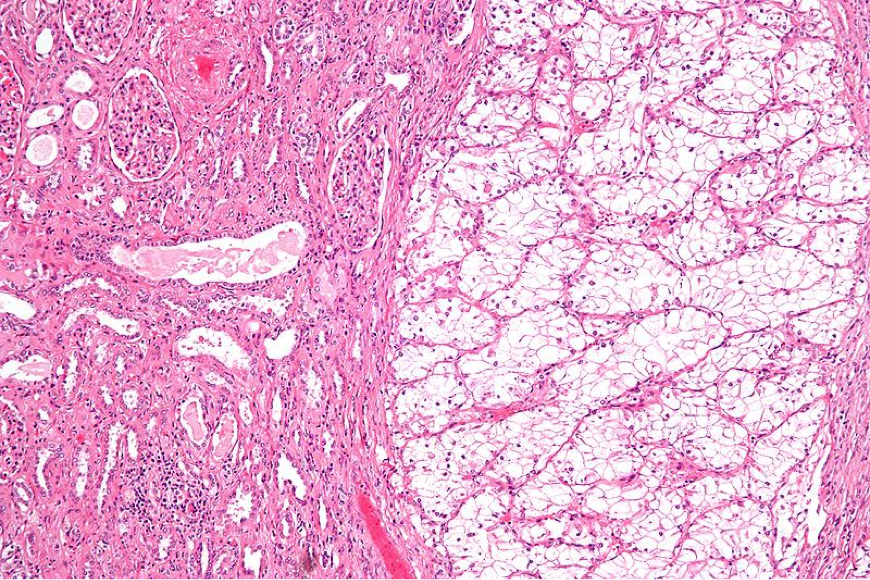WBR0374: Difference between revisions
Jump to navigation
Jump to search
Rim Halaby (talk | contribs) No edit summary |
Rim Halaby (talk | contribs) No edit summary |
||
| Line 20: | Line 20: | ||
|MainCategory=Pharmacology | |MainCategory=Pharmacology | ||
|SubCategory=Renal | |SubCategory=Renal | ||
|Prompt=A 72 year old Caucasian male patient presents to the emergency department complaining of hematuria and back pain of recent onset. The patient’s past medical history is significant for hypertension controlled on pirindopril and diabetes mellitus type II controlled on metformin. Physical examination is significant for a palpable abdominal mass. After appropriate initial work-up, renal biopsy is performed and shows the findings in the image below. If surgical intervention is not possible, which of the following pharmacologic therapies is the best treatment modality for the patient’s condition? | |Prompt=A 72 year old Caucasian male patient presents to the emergency department complaining of hematuria and back pain of recent onset. The patient’s past medical history is significant for hypertension controlled on pirindopril and diabetes mellitus type II controlled on metformin. Physical examination is significant for a palpable abdominal mass. After appropriate initial work-up, renal biopsy is performed and shows the findings in the image below. If surgical intervention is not possible, which of the following pharmacologic therapies is the best treatment modality for the patient’s condition? | ||
[[Image:Renal clear cell carcinoma.png|500px]] | [[Image:Renal clear cell carcinoma.png|500px]] | ||
Revision as of 01:58, 10 September 2013
| Author | [[PageAuthor::Rim Halaby, M.D. [1]]] |
|---|---|
| Exam Type | ExamType::USMLE Step 1 |
| Main Category | MainCategory::Pharmacology |
| Sub Category | SubCategory::Renal |
| Prompt | [[Prompt::A 72 year old Caucasian male patient presents to the emergency department complaining of hematuria and back pain of recent onset. The patient’s past medical history is significant for hypertension controlled on pirindopril and diabetes mellitus type II controlled on metformin. Physical examination is significant for a palpable abdominal mass. After appropriate initial work-up, renal biopsy is performed and shows the findings in the image below. If surgical intervention is not possible, which of the following pharmacologic therapies is the best treatment modality for the patient’s condition? |
| Answer A | AnswerA::Folic acid analog that inhibits dihydrofolate reductase |
| Answer A Explanation | AnswerAExp::Methotrexate, an antimetabolite is not an effective treatment for renal clear cell carcinoma. Methotrexate is commonly used for hematologic malignancies. |
| Answer B | AnswerB::Pyrimidine analog that inhibits DNA polymerase |
| Answer B Explanation | AnswerBExp::Similar to methotrexate, cytarabine, also an antimetabolite, is not effective in renal cell carcinoma. |
| Answer C | AnswerC::Alkaloid that blocks polymerization of microtubule in the M phase |
| Answer C Explanation | AnswerCExp::Microtubule inhibitors, such as vincristine and vinblastine, may be used Wilms’ tumor and Hodgkin’s lymphoma. |
| Answer D | AnswerD::Calcineurin inhibitor that binds to FK-binding protein |
| Answer D Explanation | AnswerDExp::Tacrolimus is a calcineurin inhibitor that binds to FK-binding protein. It is commonly used as an immunosuppressive agent for renal transplant recipients. |
| Answer E | AnswerE::Immune modulation by interleukin-2 recombinant therapy |
| Answer E Explanation | AnswerEExp::Aldesleukin, interleukin 2 recombinant cytokine, is an effective pharmacologic therapy for patients with advanced renal cell carcinoma. |
| Right Answer | RightAnswer::E |
| Explanation | [[Explanation::Renal cell carcinoma, commonly clear cell carcinoma, is a malignant kidney cancer that originates in the proximal convoluted tubule. In localized disease, partial and radical nephrectomy are both treatment options depending on the size of the tumor. Approximately 30% of patients with renal cell carcinoma are initially diagnosed with metastatic disease. While conventional cancer therapy is not effective, cytokine recombinant interleukin-2, aldesleukin, has demonstrated clinical efficacy.
New therapeutic options, including vascular endothelial growth factor (VEGF) inhibitors and mammalian target of rapamycin pathways have also been showing clinical effectiveness and may be therapeutic options for patients with metastatic renal carcinoma. Educational Objective: Aldesleukin, interleukin 2 recombinant cytokine, has been shown to be an effective pharmacologic therapy for patients with advanced renal cell carcinoma. Reference:
Rini, BI, Campbell SC, Escudier B. Renal cell carcinoma. The Lancet. 2009; 373(9669):1119-1132 |
| Approved | Approved::No |
| Keyword | |
| Linked Question | Linked:: |
| Order in Linked Questions | LinkedOrder:: |
